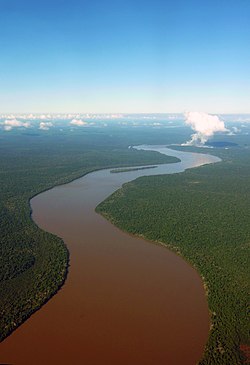Iguazu ( port. Iguaçu , Spanish. Iguazú ) is a river in South America with a length of 1320 km. Its name comes from the language of guarani and means "big water."
| Iguazu | |
|---|---|
| port. Iguaçu , Spanish Iguazú | |
 Iguazu River in Brazil Iguazu River in Brazil | |
| Characteristic | |
| Length | 1320 km |
| Pool | 62,000 km² |
| Water consumption | 1400 m³ / s |
| Watercourse | |
| Source | river confluence: Irai and Atuba |
| • Location | Serra do Mar Mountains, near Curitiba |
| • Height | 900 m |
| • Coordinates | |
| Mouth | Parana |
| • Location | 18 km from Puerto Iguazu |
| • Height | 110 m |
| • Coordinates | |
| Location | |
| Water system | Parana → Atlantic Ocean |
| Country |
|
| Regions | Parana , Santa Catarina , Misiones |


Iguazu is formed as a result of the confluence of the rivers Irai and Atuba near Curitiba in the mountains of Serra do Mar. In the upper reaches, it winds heavily, breaking off constantly by 70 waterfalls. In the middle reaches, the river becomes navigable for 500 km within the state of Parana. About 30 tributaries flow into it in this section. In the lower reaches, until it flows into the Parana River, it is the natural border between Argentina and Brazil . During floods, the river forms a gutter 7 times the size of Niagara Falls .
Iguazu has become famous for its unique waterfalls , which are 30 kilometers from the place where it flows into Parana, making a huge loop, spreading in width for 4 km. Most of the waterfalls are located on the Argentine side, where there is also the entrance to the spectacular, the so-called “Devil's Throat”. The best view is from the Brazilian side. The total width of the waterfalls is 2.7 km, every second 1700 m³ of water fall 75 meters down, after long rainfall even 7000.
Iguazu waterfalls were opened in 1542 and recognized in 1984 as a UNESCO World Heritage Site . Thanks to tourism, they are an important source of income in the district.
